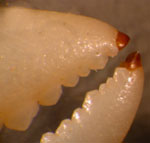Bromine-rich Tips of Calcified Crab Claws
as Model for Biomaterials
summary written by Raven Hanna
The tips of crab pincers are made of a very hard material, allowing the crab to fight and forage for food without wearing down their tools. Made mostly of proteins, the tip is known to be bromine-rich instead of calcium-rich, but the biochemical structure and mechanical properties were mostly unknown. Understanding this hard material made by crabs may lead to development of materials made by humans for use in a variety of purposes that require a small, fracture-resistant tool.
A team led by Robert Schofield of the University of Oregon and Robert Scott of the University of Georgia in Athens studies the material of crab claw tips. They found that the uncalcified, bromine-rich material is harder and stiffer than normal arthropod cuticle that lacks heavy elements and much more resistant to fracture than the calcified material in other parts of the crab.
Theorizing that the resistance to fracture comes from the arrangement of bromine atoms in the protein structure, the team collaborated with SSRL scientist Matthew Latimer to analyze the distribution and environment of bromine atoms in the crab claw tip. Using X-ray microscopy and spectroscopy at SSRL Beam Line 9-3, they found the bromine is evenly dispersed and likely bonds to phenyl rings, suggesting that a bromotyrosine moiety may be central to the special properties of this material. They hypothesize that either the bromine stiffens the material by creating more cross-links between the protein residues or the presence of the heavy atoms dampens energies created in impacts through their high electron densities. The results are published in the June issue of the Journal of Structural Biology.
To learn more about this research see the full Scientific Highlight
R. M. S. Schofield, J. C. Niedbala, M. H. Nesson, Y. Tao, J. E. Shokes, R. A. Scott and M. J. Latimer, "Br-rich Tips of Calcified Crab Claws are Less Hard but More Fracture Resistant: A Comparison of Biomineralized and Heavy-element Biomaterials", J. Struct. Biol. 166, 272 (2009)


